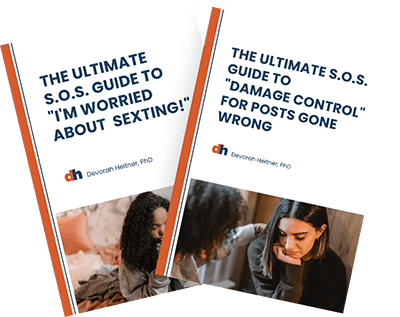 In my last post, I talked about “app development” workshops that I do with 4th–7th graders to illuminate the issues that technology introduces into our lives. We start by identifying a common problem, then trying to solve the problem with a designed solution.
In my last post, I talked about “app development” workshops that I do with 4th–7th graders to illuminate the issues that technology introduces into our lives. We start by identifying a common problem, then trying to solve the problem with a designed solution.
We talked about apps to help with impatience and persistence with regard to text messaging, group chat dynamics, and setting boundaries in kids’ use of technology. You can read the whole article here: Kids Design an App.
In the course of these workshops, the kids went beyond peer-to-peer issues. Every single kid had stories about their parents not really hearing them when they are talking, texting while they are driving, or having their kids text for them so they could drive. Some kids reported resorting to hiding their parents’ phones while they are cooking or otherwise distracted so that they can talk with them. Other kids told stories of having to repeat entire stories about their day as parents drive, text, and talk with their kids. Hearing this made me never want to risk a pedestrian crossing again!
The kids are way ahead—and again, they came up with some great solutions. I have to warn you, though. As a parent myself, these were somewhat guilt inducing, and caused me to be very self-aware. It’s a good thing, ultimately, but I can’t say that it was easy. You may have the same reactions, so there’s my disclaimer up front!
Their biggest concerns were around attention and protection, which is not surprising for this age group. Let’s look at the issues, and the solutions that the kids designed:
Parental Attention
Kids understand that smartphone technology—and the connection that comes with it—makes demands on our attention. How many times have you seen a parent focused on the “second screen” while a child tries to get his/her attention? It’s easy to spot when it’s another parent, but be honest—have you done this before? As mindful as I try to be, I know that I am guilty at times. And this is a big issue for kids.
The most common solution to this issue that the kids “designed” was a voice recognition app that temporarily disables the parent’s phone if the child is speaking in the same space. If your child is speaking in proximity to you, it disables texting, social media, and phone calls. If you are talking on the phone, it gives you an indication to end the call.
Kids recognized that it wasn’t always realistic to just stop doing whatever you’re doing—they get that parents have jobs and other stuff to do! They understand that sometimes you need to finish up what you’re doing before you can give them the attention they want. But when “5 more minutes, please” turns into an hour, they want help. One group of kids designed an app that puts a time limiter on your device. So when you say you need 5 more minutes, it grants you that—but then shuts down your phone. They appropriately named this the “5 More Minutes” app.
They also want to use the STEL app that I mentioned in my last post as a gentle reminder to their parents to “Stop Texting, Enjoy Life.” Sometimes it’s that simple, right?
Inappropriate Content
 It’s also a good sign that kids are aware that there are things they shouldn’t be seeing. They reported coming into the room, usually after bedtime, and seeing things on TV that they know is not appropriate. If you watch Scandal, House of Cards, or anything on HBO, you know what I’m talking about. The kids expressed some clever ideas about how to manage this.
It’s also a good sign that kids are aware that there are things they shouldn’t be seeing. They reported coming into the room, usually after bedtime, and seeing things on TV that they know is not appropriate. If you watch Scandal, House of Cards, or anything on HBO, you know what I’m talking about. The kids expressed some clever ideas about how to manage this.
My favorite is the “Earmuffs App,” which was spontaneously developed by one group of children in a recent workshop. If you, the parent, are watching TV with “swearing” and “inappropriate content” and your child comes into the room, the app senses it and 1) switches the content to your smartphone or tablet and 2) mutes all the “swear words.” Brilliant!
Don’t Text and Drive
When the subject of parents and their technology comes up, children invariably bring up driving. You may not text and drive, or you may not think that your kids notice when you do. But so many kids in these workshops mention the issue—it is clear that this is happening. Some kids also report that their parents ask them to text or call for them while they are driving, which is safer but still annoying as kids want to tell you about their day in the car, not play secretary.
Not only do I want to be safe, but I also want to model good behavior for the kids in the back seat. Children seem to understand the safety issues of driving distracted, but I get the sense that it’s not their primary concern. They can’t relate to the responsibility of driving, and they trust in their parents’ capability and control. For them, the issue is parental attention. They kept going back to the apps mentioned above—limiters that can turn off technology and turn on parent-to-child attention.
***
As I mentioned above, some of this was hard for me to hear. All of this suggests that parents are not listening to their kids—and that kids feel frustrated about it. Clearly, our kids want more from us than they are getting. This hit home for me as I often check email as my son plays with Lego or digs into a coloring book. While I tend to think of this as parallel play, I need to check in with if and how I am making myself “unavailable.”
This certainly echoes Catherine Steiner Adair’s findings in her book, The Big Disconnect: Protecting Childhood and Family Relationships in the Digital Age, and some of Sherry Turkle’s findings in Alone Together. App design was a great solutions-oriented way for kids to get creative around these problems and to recognize that many of them share common challenges.
Lynn Schofield Clark wrote a great book called The Parent App: Understanding Families in the Digital Age that addresses how families in different demographic groups use technology, but in reality, there is no “Parent App.” It’s up to us as parents to recognize the signs, get self-reflective, and make corrections on our own. Our kids are watching and learning from every little thing we do, and from these workshops, they are speaking loud and clear about what they need from us.
—
P.S. I hope that you’ll take this post in the right spirit. The twinges of guilt that I experienced subsided into something productive after the initial shock. I wish the same for you—that this will help you see things in a new light. As always, I welcome any comments, criticisms, observations, or new ideas. We’re all in this together!
